I could give up all meat, all dairy, all caffeine, and all desserts before I could give up peanut butter. I practically keep a jar of the stuff under my pillow; I just can’t get the day started without a spoonful, and it’s the perfect midafternoon boost when I don’t want to scrounge around for a suitable snack. My reliance on peanut butter means I purchase 40-oz. jars of the stuff, which typically costs around $7. So you can imagine how frustrated I was after my most recent grocery run, when I realized I’d wasted every penny.
I opened up the Jif jar and took a scoop, noticing immediately that the peanut butter was stiff and resistant to my spoon. I took a taste, which seemed to confirm the stuff was somehow past its prime, maybe oxidized or something. I picked up the jar to check the expiration date, but that’s when the real reason for the off flavor caught my eye: For the first time in my adult life, I’d mistakenly purchased reduced fat peanut butter instead of the regular kind.
What is reduced fat peanut butter?
In many ways, “reduced fat” anything feels like a callback to 1990s diet culture, which fixated on fat as the root of all evil. But in no product is that ’90s influence more evident than in dietetic peanut butter, a food that is naturally high in fat and oils from the legumes that form its foundation.
Reduced Fat Jif was introduced in 1995, right when the low-fat craze reached its fever pitch with products like SnackWell’s cookies and olestra potato chips. The spread has four fewer grams of fat per serving—12 grams per 2 Tbsp., compared to 16 grams in classic Jif—and one less gram of saturated fat. The two products have identical protein and calorie content.
The reduced fat product was a temporary victim of the pandemic, disappearing from shelves in 2020 as Jif streamlined its offerings in order to get out ahead of supply chain issues and focus on its core products. (We all had to say goodbye to some favorites during that time.) After much customer outcry, however, it returned to grocery stores in 2021. But even prior to the pandemic, the crunchy version had been discontinued to focus on creamy. Clearly there is a niche market for this product compared to the classic peanut butter.
The truth about reduced fat peanut butter
The FDA has some pretty clear rules surrounding what can and cannot legally be considered peanut butter. Technically speaking, all you really need to make peanut butter is peanuts and salt—and those are the only two ingredients that many of the “natural” peanut butters on the market contain. But the FDA is a bit of a cool mom when it comes to sugar, and the agency allows that certain “seasoning and stabilizing ingredients” may be permitted in the mixture. (Artificial sweeteners, on the other hand, are “not suitable.”)
If anything beyond peanuts and salt are added, those ingredients may not “in the aggregate exceed 10 percent of the weight of the finished food,” according to the FDA. Thus, all peanut butter must contain 90% peanuts. Any less than that, and the product must only be referred to as a “spread.”
Obviously, peanuts are the very thing that lend peanut butter its fat, so in order to reduce the amount of fat in peanut butter, you’ve got to reduce the peanuts. Reduced Fat Jif contains 60% peanuts instead of the 90% of the classic product. And in order to make up that peanut shortfall, the product is bulked up with a combination of corn syrup solids and pea protein. Thus, Reduced Fat Jif is not technically peanut butter—and that’s reflected on the label. As you can see in the side-by-side image below, only one jar gets to feature the phrase “peanut butter.” The other is “Creamy.” Just creamy.

Which is better, regular peanut butter or reduced fat?
Having a conversation about which of these two products is “healthier” sounds like a form of torture tailored to me specifically. I do not care to deliberate the relative “healthiness” of either peanut spread—but millions of Americans do, which is why it makes financial sense for Jif to offer both products in tandem. All I’ll say is that the reduced fat stuff takes away 33% of the peanuts for only a 25% reduction in fat. If you eat peanut butter for its peanut flavor, then that trade-off feels lopsided to me.
You also get 1 more gram of sugar per serving with reduced fat, 50 more grams of sodium, and nearly twice the amount of carbohydrates. Due to one or more of those aspects, the reduced fat spread leaves a lingering aftertaste that feels a little too cloying, though perhaps I’m the only person on earth who eats enough regular peanut butter to spot the difference.
Some people just happen to prefer the reduced fat product on the basis of taste alone; many Twitter users told me it’s what they grew up with, or that they think its thickness is superior to the creamier classic stuff. Fortunately, now that both versions have been restored to the Jif lineup, no one has to agree, and everyone can pick a side. I just wish each side weren’t so close to the other on the grocery store shelf, because that’s $7 I won’t get back.
